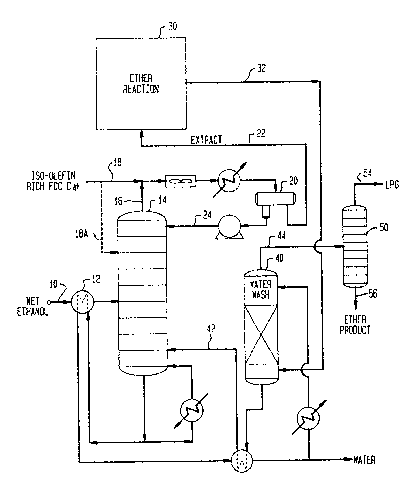Some of the information on this Web page has been provided by external sources. The Government of Canada is not responsible for the accuracy, reliability or currency of the information supplied by external sources. Users wishing to rely upon this information should consult directly with the source of the information. Content provided by external sources is not subject to official languages, privacy and accessibility requirements.
Any discrepancies in the text and image of the Claims and Abstract are due to differing posting times. Text of the Claims and Abstract are posted:
| (12) Patent: | (11) CA 2037091 |
|---|---|
| (54) English Title: | PRODUCTION OF ETHYL TERTIARY ALKYL ETHERS |
| (54) French Title: | PREPARATION D'OXYDE D'ETHYLE ET D'ALKYLE TERTIAIRE |
| Status: | Expired and beyond the Period of Reversal |
| (51) International Patent Classification (IPC): |
|
|---|---|
| (72) Inventors : |
|
| (73) Owners : |
|
| (71) Applicants : |
|
| (74) Agent: | KIRBY EADES GALE BAKER |
| (74) Associate agent: | |
| (45) Issued: | 1998-12-29 |
| (22) Filed Date: | 1991-02-26 |
| (41) Open to Public Inspection: | 1991-08-29 |
| Examination requested: | 1995-01-12 |
| Availability of licence: | N/A |
| Dedicated to the Public: | N/A |
| (25) Language of filing: | English |
| Patent Cooperation Treaty (PCT): | No |
|---|
| (30) Application Priority Data: | ||||||
|---|---|---|---|---|---|---|
|
Crude aqueous ethanol feedstock is reacted with
iso-olefinic hydrocarbons to produce C6+ ethyl t-alkyl
ethers by distilling the feedstock, contacting ethanol
rich distillate overhead containing a minor amount of
water with a liquid hydrocarbon extractant rich in C4+
isoalkene under liquid extraction conditions, recovering
an aqueous phase containing water introduced from the
overhead, recovering an organic extract phase comprising
the hydrocarbon extractant and a major amount of ethanol
introduced in the feedstock, and reacting the extracted
ethanol and C4+ isoalkene in contact with an acid
etherification catalyst under catalytic reaction
conditions to produce ether product.
Une charge d'alimentation d'éthanol aqueux brut est mis en réaction avec des hydrocarbures iso- oléfiniques pour produire des éthers C6+ ethyl t-alkyl en distillant la charge d'alimentation, en contact avec un distillat de tête riche en éthanol contenant une quantité minime d'eau avec un extractant d'hydrocarbure liquide riche en C4+ isoalkène dans des conditions d'extraction liquide, recouvrant une phase aqueuse contenant de l'eau introduite à partir du distillat de tête, recouvrant une phase d'extraction organique comprenant l'extractant d'hydrocarbure et une quantité importante d'éthanol introduite dans la charge d'alimentation et réagissant avec l'éthanol extrait C4+ isoalkène en contact avec un catalyseur d'éthérification acide sous des conditions catalytiques pour produire un produit d'éther.
Note: Claims are shown in the official language in which they were submitted.
Note: Descriptions are shown in the official language in which they were submitted.

2024-08-01:As part of the Next Generation Patents (NGP) transition, the Canadian Patents Database (CPD) now contains a more detailed Event History, which replicates the Event Log of our new back-office solution.
Please note that "Inactive:" events refers to events no longer in use in our new back-office solution.
For a clearer understanding of the status of the application/patent presented on this page, the site Disclaimer , as well as the definitions for Patent , Event History , Maintenance Fee and Payment History should be consulted.
| Description | Date |
|---|---|
| Time Limit for Reversal Expired | 2004-02-26 |
| Letter Sent | 2003-02-26 |
| Inactive: Cover page published | 2001-08-31 |
| Inactive: Acknowledgment of s.8 Act correction | 1999-01-19 |
| Inactive: Prior art correction | 1999-01-19 |
| Inactive: S.8 Act correction requested | 1999-01-11 |
| Grant by Issuance | 1998-12-29 |
| Inactive: Delete abandonment | 1998-10-22 |
| Deemed Abandoned - Conditions for Grant Determined Not Compliant | 1998-07-28 |
| Pre-grant | 1998-07-27 |
| Inactive: Final fee received | 1998-07-27 |
| Notice of Allowance is Issued | 1998-01-28 |
| Notice of Allowance is Issued | 1998-01-28 |
| Letter Sent | 1998-01-28 |
| Inactive: Application prosecuted on TS as of Log entry date | 1998-01-21 |
| Inactive: Status info is complete as of Log entry date | 1998-01-21 |
| Inactive: IPC assigned | 1997-12-10 |
| Inactive: IPC removed | 1997-12-10 |
| Inactive: IPC assigned | 1997-12-10 |
| Inactive: IPC removed | 1997-12-10 |
| Inactive: First IPC assigned | 1997-12-10 |
| Inactive: Approved for allowance (AFA) | 1997-12-10 |
| Inactive: IPC assigned | 1997-12-10 |
| Inactive: IPC removed | 1997-12-10 |
| Request for Examination Requirements Determined Compliant | 1995-01-12 |
| All Requirements for Examination Determined Compliant | 1995-01-12 |
| Application Published (Open to Public Inspection) | 1991-08-29 |
| Abandonment Date | Reason | Reinstatement Date |
|---|---|---|
| 1998-07-28 |
The last payment was received on 1997-12-08
Note : If the full payment has not been received on or before the date indicated, a further fee may be required which may be one of the following
Please refer to the CIPO Patent Fees web page to see all current fee amounts.
| Fee Type | Anniversary Year | Due Date | Paid Date |
|---|---|---|---|
| MF (application, 7th anniv.) - standard | 07 | 1998-02-26 | 1997-12-08 |
| Final fee - standard | 1998-07-27 | ||
| MF (patent, 8th anniv.) - standard | 1999-02-26 | 1999-02-11 | |
| MF (patent, 9th anniv.) - standard | 2000-02-28 | 2000-02-02 | |
| MF (patent, 10th anniv.) - standard | 2001-02-26 | 2001-02-01 | |
| MF (patent, 11th anniv.) - standard | 2002-02-26 | 2002-01-07 |
Note: Records showing the ownership history in alphabetical order.
| Current Owners on Record |
|---|
| MOBIL OIL CORPORATION |
| Past Owners on Record |
|---|
| HARTLEY OWEN |
| MOHSEN N. HARANDI |